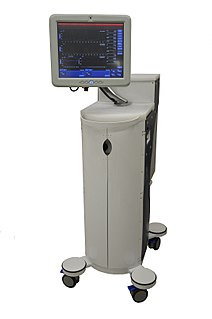
Dual-control modes of ventilation are auto-regulated pressure-controlled modes of mechanical ventilation with a user-selected tidal volume target. The ventilator adjusts the pressure limit of the next breath as necessary according to the previous breath's measured exhaled tidal volume. Peak airway pressure varies from breath to breath according to changes in the patient's airway resistance and lung compliance.
Pressure control (PC) is a mode of mechanical ventilation alone and a variable within other modes of mechanical ventilation. Pressure control is used to regulate pressures applied during mechanical ventilation. Air delivered into the patients lungs (breaths) are currently regulated by Volume Control or Pressure Control. In pressure controlled breaths a tidal volume achieved is based on how much volume can be delivered before the pressure control limit is reached.
Modes of mechanical ventilation are one of the most important aspects of the usage of mechanical ventilation. The mode refers to the method of inspiratory support. In general, mode selection is based on clinician familiarity and institutional preferences, since there is a paucity of evidence indicating that the mode affects clinical outcome. The most frequently used forms of volume-limited mechanical ventilation are intermittent mandatory ventilation (IMV) and continuous mandatory ventilation (CMV). There have been substantial changes in the nomenclature of mechanical ventilation over the years, but more recently it has become standardized by many respirology and pulmonology groups. Writing a mode is most proper in all capital letters with a dash between the control variable and the strategy

Tidal volume is the lung volume representing the normal volume of air displaced between normal inhalation and exhalation when extra effort is not applied. In a healthy, young human adult, tidal volume is approximately 500 mL per inspiration or 7 mL/kg of body mass.
Contents
The pressure waveform is square, and the flow waveform is decelerating. This mode is a form of continuous mandatory ventilation as a minimum number of passive breaths will be time-triggered, and patient-initiated breaths are time-cycled and regulated according to operator-set tidal volume. [1]
Continuous mandatory ventilation (CMV) is a mode of mechanical ventilation in which breaths are delivered based on set variables. Still used in the operating room, in previous nomenclature CMV referred to "controlled mechanical ventilation", a mode of ventilation characterized by a ventilator that makes no effort to sense patient breathing effort. In continuous mandatory ventilation, the ventilator can be triggered either by the patient or mechanically by the ventilator. The ventilator is set to deliver a breath according to parameters selected by the operator. "Controlled mechanical ventilation" is an outdated expansion for "CMV"; "continuous mandatory ventilation" is now accepted standard nomenclature of mechanical ventilation. CMV today can assist or control dynamically, depending on transient presence or absence of spontaneous breathing effort. Thus, today's CMV would have been called ACV in older nomenclature, and the original form of CMV is a thing of the past. But despite continual technological improvement over the past half century, CMV sometimes may still be uncomfortable for the patient.
The first few breaths are delivered to the patient according to the ventilator manufacturer's particular algorithm for determining the patient's resistance and compliance. These are 'test breaths' that the ventilator can then use to calculate the optimal pressures for the next, regulated breaths. The pressure is constant during the set inspiratory time as with pressure-controlled CMV. The ventilator will use the exhaled tidal volume measured at the end of that breath's expiratory phase to calculate the pressure of the next breath. If the exhaled tidal volume is lower than the software threshold, the next breath will be delivered at a higher pressure, and if the exhaled tidal volume is higher than the software threshold, the next breath will be delivered at a lower pressure.
The theory is to ensure that the lowest inspiratory pressure necessary to achieve the desired tidal volume is used. As a safety feature, the ventilator will not increase the pressure beyond a predetermined high pressure limit. This is usually tied to (but not the same as) the operator-set high pressure alarm setting. If the ventilator delivers a breath at this high pressure limit and is still unable to achieve the operator-desired exhaled tidal volume, an alarm will sound to warn the operator that the volume target cannot be met.





